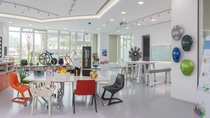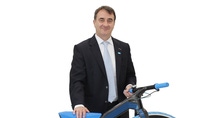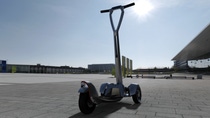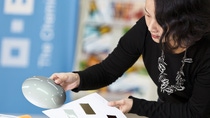Design inspires innovation

How do you select appropriate materials for products to make them cost-effective, energy-saving, user-friendly and nice looking? This is what concerns designers, engineers and developers these days.
In 2004, designers Ronan Bouroullec and Erwan Bouroullec were obsessed with the concept of a “Vegetal Chair”. The Frenchmen dreamed of making chairs that would grow into the shape of organic plants. However, the design structure of the branches directly affected the flowing smoothness of plastics in molds, which made their mass production seem impossible. While such a design demonstrated great originality, the problem was what materials could be used to achieve such a complex manufacturing process with characteristics of comfort and practicality?
To solve the problem of plastic’s fluidity in molds, the pair cooperated with Vitra, the renowned Swiss furniture manufacturer, and BASF, the world’s leading material supplier. BASF’s experts helped them conduct a simulation analysis of materials and found problems in their molds and technological processes. Given that the materials of the vegetal chairs need to be highly liquid, lightweight and durable, the design team chose to use BASF’s plastic Miramid®. After four years of efforts, the Vegetal chairs debuted at the end of 2008, looking as if they were woven with branches of different thickness albeit very firm and weighing only 5.5 kilograms. The chairs can be used both indoors and outdoors because their color won’t fade in sunlight.
Nowadays, several Vegetal chairs in distinctive colors are displayed at the new BASF Design Center Asia Pacific in Shanghai. The center features resources from many different BASF operating divisions, such as the Concept 1865 bicycle engraved with 24 types of BASF high performance materials. Other items include JOIN tableware made of Ultramid®, a solar-powered e-floater weighting less than 12kg and adidas trend-setting running shoes.

The function of the new Design Center is to embrace designers from China and the Asia-Pacific region. It is also to provide consultation services, R&D support or simulation and testing devices for them to narrow the distance between the material and design industries. BASF will host design-related activities for coating solutions, care chemicals, construction chemicals, pigments, leather chemicals and performance materials through this hub for Asia Pacific, and provide advanced solutions for multiple industries including automotive, cosmetics, building and consumer goods.
The Design Center is located at the BASF Innovation Campus Asia Pacific (Shanghai), the company’s largest R&D site in the region and the global headquarters of BASF's Advanced Materials and Systems Research.
“The Innovation Campus Asia Pacific creates an ideal environment for the Design Center, and promotes cross-disciplinary cooperation”, said Dr. Harald Lauke, President, Advanced Materials and Systems Research, Regional Research Representative for Asia Pacific, BASF. “With our design expertise, we want to translate inventions into daily products that enhance quality of life by connecting industrial designers with BASF researchers, developers and business experts.”
Eva von Traitteur, Head of BASF Design Center Asia Pacific in Shanghai introduced that with work experience in different industries, consultants at the new Design Center are an interface between different disciplines such as chemistry, materials, engineering marketing and design. With experience in furniture, transportation, consumer goods and other industries, and an understanding of market and production, they play an important role in connecting R&D and the business personnel of BASF with external customers.
“Design is the interface between users and the function of a product. Our mission is to be the first point of contact at BASF for all design-driven industries”, said Ms. von Traitteur. “We collaborate closely with teams across R&D and business divisions with diverse materials, processing and industry expertise under the same roof. This makes it easier to develop original solutions with a long-term horizon, in addition to providing ongoing design consultancy for our customers.”
As for designers, a good concept is just the beginning of a creation - they need to know the usage and production modes of materials. The BASF Design Center Asia Pacific therefore plans a set of unique originality processes, reflecting an all-round service from inspiration, ideation to implementation. Consultants get involved from an early stage of product development.
BASF color designers support BASF Coatings Solutions division, where color is one of our key success factors. The color teams around the world serve different regions. In Europe, the color design team is located in Muenster, Germany. In North America, it is in Southfield, USA. In Asia Pacific, they are here in Shanghai and Yokohama, Japan. All color designers work as ONE global team, analyzing color trends and issuing yearly global and local trend reports and color forecasts. Together with the application team, the color designers develop customer-specific colors.
BASF Care Chemicals division focuses on product experience and customer engagement with sample exploration. To touch, smell and see the product are key elements for success in the market. Experiencing the sensorial aspects with samples are elementary for a precise definition of customer needs. In addition, they test the functional performance and more quantified sensorial aspects in the sensorial lab to characterize successful products.
In 2016, following Ludwigshafen, Germany, and Tokyo, BASF established a new designfabrik® in Shanghai, as part of the new Design Center Asia Pacific with a focus on advance products made out of plastic. Founded in 2006 in BASF’s global headquarters in Ludwigshafen, designfabrik® is a design consultancy institution supporting the BASF Performance Materials division. Its creation was the first time in the plastics sector that a raw materials producer had offered a special platform for a target group of industrial designers.
“At designfabrik® we will assist designers realize even the most daring ideas,” said Andy Postlethwaite, Senior Vice President, Performance Materials Asia Pacific, BASF.
Furthermore, consultants conduct application development by fully leveraging BASF’s expertise in various fields, and material experts in the company enable customers to have a full understanding of the performance of materials.
With the help of computer simulation patent technology ULTRASIM®, BASF engineers can accurately predict the performance of components, calculate the resilience of final-finished products and recommend the most suitable manufacturing process. The technology can also help customers solve problems and effectively eliminate the hidden dangers of performance in the stage of tool design, production and post-production. This greatly improves economic efficiency and accelerates the time for products entering the market.
The expert team at BASF is the last step to realizing design concept. With their understanding of material characteristics and professional ability in process optimization, design concept and mass production are both realized.
So what is the purpose of design? Where is the difference between meaningful design and a meaningless one? This is a problem that BASF faces when it sets out in the design field in the upstream from the raw-material field.
The continuous growth of the global population and urbanization brings great challenges to resources, environment, transportation, food and living quality. Therefore, BASF is committed to seeking better solutions focused on urban living, future living and smart living.
Almost 80% of the lightweight, solar-powered scooter “e-floater” is made of BASF composite materials and plastics, which have excellent vibration-absorption performance and promote the development of sustainable city transportation.
Using BASF’s new foam InfinergyTM, adidas has developed a new running shoe with unique spring and cushioning properties. Its midsole is made from a new particle foam, whose high rebound effect provides runners with unparalleled energy return, enabling them to enjoy the fun of running.
Jointly created by BASF and renowned designer Chris Lefteri, the “Living Space Concept” exhibition has moved from Singapore to Shanghai. It displays the design application of BASF’s innovative materials in furniture, consumer-electronic equipment and household appliances. The exhibition highlights the trends, challenges and living spaces of future residents in different stages of life – but creativity is more than this.
BASF is inviting people who love innovation to join in, encouraging designers to draw inspiration from BASF materials, develop cooperation and jointly solve the challenges of urban living through design competitions and cooperative projects among universities. It aims to make design and innovation help to provide a more healthy, intelligent and sustainable life for the society.
“BASF’s innovation in materials is the main source of inspiration of outstanding products, which is best interpreted and transferred by a good design work”, said Dr. Lauke. “We will continue cooperating with customers and partners in the region to jointly explore more innovative and sustainable solutions.”
Selecting appropriate materials for products is always the most challenging decision for designers, engineers and developers. “With BASF Design Center Asia Pacific we offer a platform to solve that problem”, said Ms. von Traitteur. “The design thinking process in the Design Center Asia Pacific reflects the combination of technology, demand and materials. Many excellent designs, which couldn’t be achieved in the past due to choosing the wrong materials or production methods, can now be implemented. We believe design can further inspire innovation for future.”

